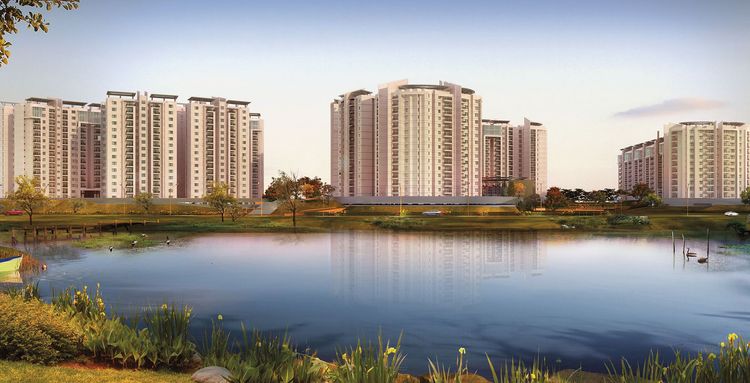On June 12, 2025, Air India Flight AI 171 - a Boeing 787 Dreamliner bound for London crashed into a hostel building just 36 seconds after takeoff from Ahmedabad. This heart-wrenching incident claimed 241 lives on board and dozens on the ground.
While the reasons for the crash are still being formally looked at, the incident brings attention to an important but often overlooked aspect of urban development near airports: ‘Height restrictions on construction and vegetation.’
According to the Aircraft Act and the Ministry of Civil Aviation’s “Height Restrictions for Safeguarding Aircraft Operations” Rules, 2015:
No construction or planting is allowed within a 20 km radius of an airport’s Aerodrome Reference Point (ARP) without prior No Objection Certificate (NOC) from the Airports Authority of India (AAI), irrespective of the height or type of structure.
This includes:
- Buildings (residential, commercial, industrial)
- Communication towers, chimneys, antennas
- Trees or plantations that could grow into flight paths
These rules apply across the country and are crucial for maintaining the safety of aircraft operations during key phases of flight.
Understanding OLS
To understand height restrictions near airports, first we’ll guide you how aircraft actually operate during takeoff and landing.
In aviation, every flight passes through three critical phases near the airport:
- Takeoff – when the aircraft accelerates on the runway and lifts off into the air
- Climb – when it gains height to reach its cruising altitude
- Approach – when it begins descending and aligns itself to land safely on the runway
Each of these stages happens close to the airport and at relatively low altitudes, which makes them especially sensitive to obstacles.
To keep aircraft safe during takeoff, climb and landing, airports are surrounded by invisible 3D safety zones known as Obstacle Limitation Surfaces (OLS). These are defined by the DGCA (Directorate General of Civil Aviation) and act as protective airspace which ensures no structure interferes with flight paths.
Each surface has its own shape, slope and radius to limit how tall anything can be near an airport.
Here’s a quick breakdown:
Approach Surface
Extends outward from the ends of the runway and protects the airspace that aircraft use while coming in to land.
Any building within this zone must stay below this slope to ensure safe take-off and landing paths for aircraft.
Take-off Climb Surface
Starts at the end of the runway and stretches outward and upward. It ensures aircraft have a clear path as they lift off and begin to climb.
Inner Horizontal Surface
A flat, circular zone around the airport where strict height limits apply as this creates a buffer above the terminal area.
Conical Surface
A sloping surface that rises gradually from the edge of the inner horizontal surface. Imagine it as an invisible, cone-shaped dome protecting aircraft as they move vertically.
Transitional Surface
Slopes up from the sides of the runway and taxiways, which prevent side obstructions near the aircraft’s low-altitude path.
In cities like Bangalore, height restrictions apply around both Kempegowda International Airport (KIA) and HAL Airport.
Even though byelaws don’t always spell this out, these zones are governed by AAI and DGCA zoning maps. Developers and landowners must apply for height clearance based on their project’s location relative to the airport and the applicable OLS.
What This Means for Real Estate Projects
If you’re building or buying near an airport, height restrictions directly affect what can or can’t be constructed in your area.
Here’s how different OLS zones translate into real-world height limits for real estate:
Inner Horizontal Surface
- This is a flat circular zone with a typical radius of 4,000 metres from the runway.
- Within this zone, building height is capped usually around 45 metres Above Ground Level (AGL), though the exact figure may vary by airport.
- Projects here are strictly monitored and even small deviations need formal clearance from AAI.
Conical Surface
- The conical surface extends outward and upward from the edge of the inner horizontal surface.
- Here, height restrictions become more flexible but they’re still controlled.
- In general, buildings between 45 and 100 metres might be permitted but only after specific approvals and safety assessments.
- The further you are from the runway, the more height will be allowed but NOC is still mandatory.
Airport Funnel
- The Airport Funnel is the most critical zone, aligned with the runway ends where planes take off and land.
- In this zone, height is directly proportional to distance from the runway:
Permitted Height = 2% of the distance from the runway edge(e.g., if your building is 1,000 metres from the edge of the runway, the max height allowed is just 20 metres.)
This CDP of HAL Airport in Bangalore shows which part of the neighbourhood will come under height restrictions rules due to Airport funnel and Conical Surface.
Understanding this map can help you determine whether your apartment complies with the required safety norms regarding building heights. It’s essential for ensuring that your property is within safe limits and adheres to aviation safety standards.
What is AMSL & AGL in Height Restriction?
AMSL stands for Above Mean Sea Level, a key reference used in aviation-related height restrictions, including building construction near airports.
Why is AMSL used for height limits?
In airport funnel zones and DGCA/AAI regulations:
- Aircraft operate based on altitude above sea level, not above ground.
- To ensure safety, building heights are measured relative to Mean Sea Level (MSL) not just local ground level.
Two Common Terms Compared:
When you apply for height clearance near an airport, the Airports Authority of India (AAI) doesn’t just look at how tall your building is from the ground. They look at the total height of your building measured from sea level also known as AMSL.
Here’s how it works:
What AAI Calculates?
Total Height = Ground Elevation of Your Plot + Proposed Building Height
This combined height is then compared against the maximum AMSL height allowed at your specific location, based on Obstacle Limitation Surfaces (OLS).
A Real Example
Let’s say you’re building near Kempegowda International Airport (KIA), where the airport elevation is approximately 915 metres AMSL.
Now consider this:
- Your site is at 920 metres AMSL
- You propose a building of 40 metres in height
So your total structure height becomes: 920 + 40 = 960 metres AMSL
If AAI’s allowed height limit for your location is 950 metres AMSL, your proposal exceeds the safe limit by 10 metres.In this case, AAI will either:
- Reject the proposal, or
- Ask you to reduce your building height to meet the safety limit.
Why This Matters
- Even if your building seems normal in height from the ground, its elevation from sea level could breach safety limits.
- Projects on naturally elevated plots (like on a hill or plateau) are more likely to hit these caps faster.
- Always check both the ground elevation and the maximum AMSL cap before finalising building height, especially near airports.
How Do These Rules Affect Real Estate Projects?
- AAI clears or rejects proposals based on AMSL, not just number of floors.
- Any building above 15 m AGL must secure height NOC from AAI via NOCAS.
- Projects violating the height may be denied Occupancy Certificate (OC) or construction approval altogether.
Key Affected Areas in Bangalore
If you’re considering buying or building property in Bangalore, it’s important to know whether the area falls under airport height restriction zones. Here’s a quick breakdown:
Real Stories from Bangalore: When Height Violations Cost Developers & Buyers
Case 1: 7 Floors to be Demolished in Koramangala
One of the luxurious residential projects in Koramangala is now facing the demolition of 7 out of 17 floors. That's because the building violated height restrictions imposed by HAL (Hindustan Aeronautics Ltd), whose aerodrome zoning guidelines were breached during construction.
Following a Karnataka High Court order the floors are now being removed, a move that:
- Delivers a huge financial hit to the developer
- Impacts buyers who had already purchased units on those floors
- Raises the possibility of increased prices on the remaining floors to recover losses
Case 2: A 15m Violation Due to Wrong AMSL Assumptions
In another project near Bangalore airport, a miscalculation in ground elevation (AMSL) led to an unintentional but serious violation:
- Initial assumption: Site elevation = 879m AMSL
- Permissible AMSL for the area = 921m
- So, developers believed they had clearance to build up to 42m
But later, it was discovered that the actual ground elevation was 902m, not 879m.
That meant the allowable height was only: 921 - 902 = 19m. Instead, the builder had already constructed an 11-floor building of 34m, overshooting the limit by 15 metres.
This kind of error whether intentional or not can:
- Trigger demolition or modification notices
- Delay Occupancy Certificates (OC)
- Lead to legal complications for the developer and uncertainty for homebuyers
What These Cases Teach Us
- Accurate site elevation (AMSL) matters as it's the baseline for calculating legal building height.
- NOC from AAI is not a formality as it’s a non-negotiable safety requirement.
- Buyers must ask for the AAI Height NOC, especially in areas near HAL, KIA, or Jakkur.
Our market wizards at Propsoch checks every builder claim so you don’t become the next case study.
Legal & Financial Consequences of Height Violations for Homebuyers
When a building violates airport height restrictions, it can lead to serious legal action, financial losses and distress for homebuyers.
Here’s what can happen:
Court-Ordered Demolitions
If a project is found to have breached aviation safety norms, the High Court or relevant authorities can mandate demolition of the illegal portions.In such cases:
- Developers are legally bound to comply with the order.
- There’s often no alternative workaround, regardless of investment or construction stage.
Temporary Relocation
If partial demolition is ordered, existing residents may be forced to vacate temporarily.In cases of full demolition, they’ll have to:
- Find alternate accommodation at their own cost, or
- Depend on the developer to provide a solution, which may not always happen smoothly.
Compensation for Homebuyers
If you’ve bought a flat on an affected floor:
- You may be entitled to compensation, depending on the court ruling and consumer protection laws.
- This could include refunds, interest payouts or alternate arrangements However, the process is often lengthy and emotionally taxing.
Refund of Payments
If the project becomes:
- Uninhabitable, or
- Legally non-occupiable due to demolition or lack of Occupancy Certificate (OC),then homebuyers have the right to demand a full refund of their investment, including booking amount, EMIs paid or registration fees.
One Last Thing
We know this isn’t the kind of stuff you think about when dreaming of a new home. But that's exactly why it matters.
Nobody tells you about height caps, AMSL, or airport funnels when you're falling for the view from the 14th floor. And yet, it’s the difference between living peacefully and living in limbo.
If you're feeling unsure about a project, whether it’s legal, compliant, or just... too close to the runway for comfort, don’t try to decode it all on your own.
Sometimes, all it takes is someone who knows how this works to look at the documents and say, “Yeah, this is fine.” Or, "just Run.”
So if you’re even a little confused, even a little unsure, reach out to us at propsoch.com. Because at Propsoch, that’s what we’re here for. Not to sell you a home but to help you find the right one.







